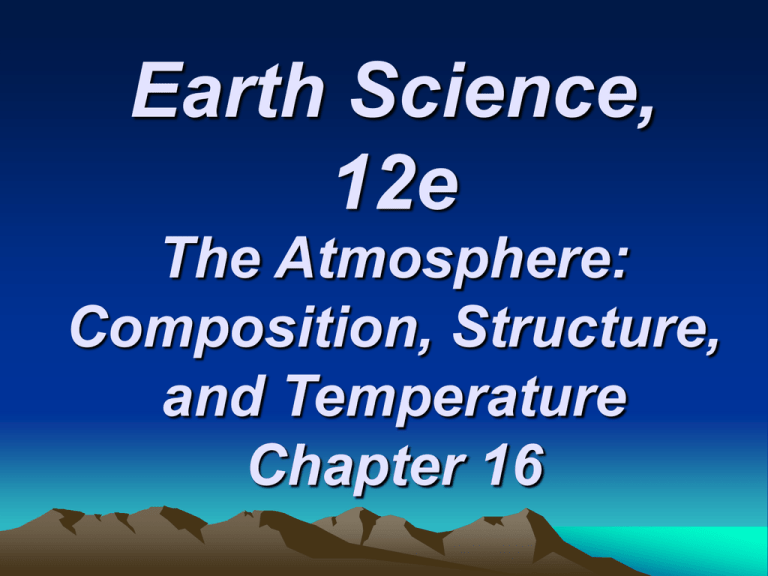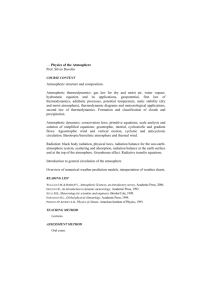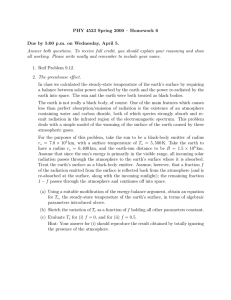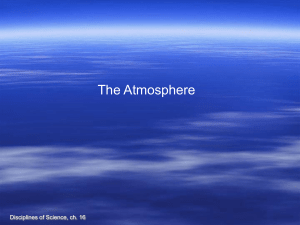Earth Science, 12e The Atmosphere: Composition, Structure,
advertisement

Earth Science, 12e The Atmosphere: Composition, Structure, and Temperature Chapter 16 Weather and climate Weather • Weather is over a short period of time • Constantly changing Climate • Climate is over a long period of time • Generalized composite of weather Weather and climate Elements of weather and climate • Properties that are measured regularly • Most important elements • • • • • • Temperature Humidity Cloudiness Precipitation Air Pressure Wind speed and direction Composition of the atmosphere Air is a mixture of discrete gases Major components of clean, dry air • • • • Nitrogen (N2) – 78% Oxygen (O2) – 21% Argon and other gases Carbon dioxide (CO2) – 0.038% – absorbs heat energy from Earth Proportional volume of gases that compose dry air Figure 16.4 Composition of the atmosphere Variable components of air • Water vapor • Up to about 4% of the air’s volume • Forms clouds and precipitation • Absorbs heat energy from Earth • Aerosols • • • • Tiny solid and liquid particles Water vapor can condense on solids Reflect sunlight Help color sunrise and sunset Composition of the atmosphere Variable components of air • Ozone • Three atoms of oxygen (O3) • Distribution not uniform • Concentrated between 10 to 50 kilometers above the surface • Absorbs harmful UV radiation • Human activity is depleting ozone by adding chlorofluorocarbons (CFCs) Structure of the atmosphere Pressure changes • Pressure is the weight of the air above • Average sea level pressure • Slightly more than 1,000 millibars • About 14.7 pounds per square inch • Pressure decreases with altitude • One-half of the atmosphere is below 3.5 miles (5.6 km) • Ninety percent of the atmosphere is below 10 miles (16 km) Atmospheric pressure variation with altitude Figure 16.6 Structure of the atmosphere Atmospheric layers based on temperature • Troposphere • Bottom layer • Temperature decreases with altitude – called the environmental lapse rate • 6.5˚C per kilometer (average) • 3.5˚F per 1,000 feet (average) • Thickness varies – average height is 12 km • Outer boundary is named the tropopause Structure of the atmosphere Atmospheric layers based on temperature • Stratosphere • About 12 km to 50 km • Temperature increases at top • Outer boundary is named the stratopause • Mesosphere • About 50 km to 80 km • Temperature decreases • Outer boundary is named the mesopause Structure of the atmosphere Atmospheric layers based on temperature • Thermosphere • No well-defined upper limit • Fraction of atmosphere’s mass • Gases moving at high speeds Thermal structure of the atmosphere Figure 16.8 Earth–Sun relations Earth motions • Rotates on its axis • Revolves around the Sun Seasons • Result of • Changing Sun angle • Changing length of daylight Daily paths of the Sun at 40º N latitude Figure 16.10 A Relationship of Sun angle and solar radiation received Figure 16.11 Earth–Sun relations Seasons • Caused by Earth’s changing orientation to the Sun • Axis is inclined 23½º • Axis is always pointed in the same direction • Special days (Northern Hemisphere) • Summer solstice • June 21–22 • Sun’s vertical rays are located at the Tropic of Cancer (23½º N latitude) Relationship of Sun angle to the path of solar radiation Figure 16.12 Earth–Sun relations Seasons • Special days (Northern Hemisphere) • Winter solstice • December 21–22 • Sun’s vertical rays are located at the Tropic of Capricorn (23½º S latitude) • Autumnal equinox • September 22–23 • Sun’s vertical rays are located at the Equator (0º latitude) Earth–Sun relations Seasons • Special days (Northern Hemisphere) • Spring (Vernal) equinox • March 21–22 • Sun’s vertical rays are located at the Equator (0º latitude) Earth–Sun relationships Figure 16.13 Characteristics of the solstices and equinoxes Figure 16.14 Atmospheric heating Heat is always transferred from warmer to cooler objects Mechanisms of heat transfer • Conduction through molecular activity • Convection • Mass movement within a substance • Usually vertical motions • Radiation (electromagnetic radiation) • Velocity: 300,000 kilometers (186,000 miles) per second in a vacuum Mechanisms of heat transfer Figure 16.17 Atmospheric heating Mechanisms of heat transfer • Radiation (electromagnetic radiation) • Consists of different wavelengths • Gamma (very short waves) • X-rays • Ultraviolet (UV) • Visible • Infrared • Microwaves and radio waves The electromagnetic spectrum Figure 16.18 Atmospheric heating Mechanisms of heat transfer • Radiation (electromagnetic radiation) • Governed by basic laws • All objects, at whatever temperature, emit radiation • Hotter objects radiate more total energy per unit area than do cooler objects • The hotter the radiating body, the shorter the wavelength of maximum radiation • Objects that are good absorbers of radiation are good emitters as well Atmospheric heating Incoming solar radiation • Atmosphere is largely transparent to incoming solar radiation • Atmospheric effects • Reflection – albedo (percent reflected) • Scattering • Absorption • Most visible radiation reaches the surface • About 50% absorbed at Earth’s surface Average distribution of incoming solar radiation Figure 16.20 Atmospheric heating Radiation from Earth’s surface • Earth reradiates radiation (terrestrial radiation) at the longer wavelengths • Longer wavelength terrestrial radiation is absorbed by • Carbon dioxide and • Water vapor in the atmosphere • Lower atmosphere heated from Earth’s surface • Heating of the atmosphere is termed the greenhouse effect The heating of the atmosphere Figure 16.22 Temperature measurement Daily maximum and minimum Other measurements • • • • • Daily mean temperature Daily range Monthly mean Annual mean Annual temperature range Mean monthly temperatures for two locations in Canada Figure 16.27 Mean monthly temperatures for two coastal locations Figure 16.29 Temperature measurement Human perception of temperature • Anything that influences the rate of heat loss from the body also influences the sensation of temperature • Important factors are • • • • Air temperature Relative humidity Wind speed Sunshine Controls of temperature Temperature variations Receipt of solar radiation is the most important control Other important controls • Differential heating of land and water • • • • Land heats more rapidly than water Land gets hotter than water Land cools faster than water Land gets cooler than water Controls of temperature Other important controls • • • • Altitude Geographic position Cloud cover Albedo World distribution of temperature Temperature maps • Isotherm – a line connecting places of equal temperature • Temperatures are adjusted to sea level • January and July are used for analysis because they represent the temperature extremes World distribution of temperature Global temperature patterns • Temperature decreases poleward from the tropics • Isotherms exhibit a latitudinal shift with the seasons • Warmest and coldest temperatures occur over land World distribution of temperature Global temperature patterns • In the Southern Hemisphere • Isotherms are straighter • Isotherms are more stable • Isotherms show ocean currents • Annual temperature range • Small near equator • Increases with an increase in latitude • Greatest over continental locations World mean sea-level temperatures in January Figure 16.32 World mean sea-level temperatures in July Figure 16.33





